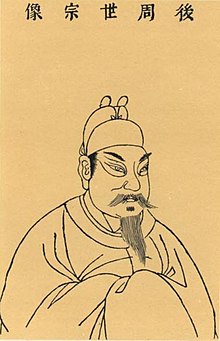Chai Rong
| Guo Rong / Chai Rong | |||||||||||||||||
|---|---|---|---|---|---|---|---|---|---|---|---|---|---|---|---|---|---|
| Emperor Shizong of (Later) Zhou (more...) | |||||||||||||||||

an illustration from Sancai Tuhui (1609)
|
|||||||||||||||||
| 2nd emperor of Later Zhou | |||||||||||||||||
| Reign | 26 February 954 – 27 July 959 | ||||||||||||||||
| Predecessor | Guo Wei (Emperor Taizu), uncle by marriage and adoptive father | ||||||||||||||||
| Successor | Chai Zongxun (Emperor Gong), son | ||||||||||||||||
| Born |
27 October 921 modern Xingtai, Hebei |
||||||||||||||||
| Died | 27 July 959 (aged 37) Kaifeng, Henan, China |
||||||||||||||||
| Burial | in today's Xinzheng, Henan 34°33′44.52″N 113°41′47.88″E / 34.5623667°N 113.6966333°E | ||||||||||||||||
| Spouse |
|
||||||||||||||||
| Issue first 3 sons died young in 950 |
|
||||||||||||||||
|
|||||||||||||||||
| Father | Chai Shouli (柴守禮) (biological) Guo Wei (adoptive) |
||||||||||||||||
| Full name | |
|---|---|
|
Surname: Chái (), later changed to Guō () Given name: Róng () |
|
| Era dates | |
| Xiǎndé (), continued from Emperor Taizu Year 1: 6 February 954 – 26 January 955 Year 2: 27 January 955 – 14 February 956 Year 3: 15 February 956 – 2 February 957 Year 4: 3 February 957 – 22 January 958 Year 5: 23 January 958 – 10 February 959 Year 6: 11 February 959 – 30 January 960 |
|
| Posthumous name | |
| Emperor Ruìwǔ Xiàowén () | |
| Temple name | |
| Shìzōng () |
| Chai Rong | |||||||||||||||
| Traditional Chinese | |||||||||||||||
|---|---|---|---|---|---|---|---|---|---|---|---|---|---|---|---|
| Simplified Chinese | |||||||||||||||
|
|||||||||||||||
| Transcriptions | |
|---|---|
| Standard Mandarin | |
| Hanyu Pinyin | Chái Róng |
| Wade–Giles | Ch'ai2 Jung2 |
| Yue: Cantonese | |
| Yale Romanization | Chaai4 Wing4 |
| Jyutping | Caai4 Wing4 |
Chai Rong (柴榮) (27 October 921 – 27 July 959) or Guo Rong (郭榮), also known by his temple name Shizong (世宗), was the second emperor of imperial China's short-lived Later Zhou during the Five Dynasties and Ten Kingdoms period, reigning from 954 until his death. He succeeded his uncle-in-law Guo Wei, whose surname he had adopted.
Emperor Shizong is considered a highly successful emperor of the Five Dynasties period. He centralized military power by his reforms, and proved his military prowess by a series of victories against Northern Han, Later Shu, Southern Tang, and the Liao Dynasty. Although his accomplishments were limited due to his premature death, they paved way for Chinese reunification later completed by the Song Dynasty, founded by his trusted general Zhao Kuangyin.
Chai Rong was born in Xingzhou (邢州; modern Xingtai, Hebei). As a child he came to live with his aunt — a younger sister of his father Chai Shouli (柴守禮) — and her husband Guo Wei, an official in the Later Tang military. The Guos had no sons, so they adopted the quiet nephew as their own. The youngster grew up into a muscular young man skilled at mounted archery, while also possessing a basic understanding of Chinese classics, history, and the Huang-Lao philosophy.
After the establishment of the Later Han in 947, the Guo family's condition improved dramatically. Guo Wei became the commissioner of military affairs (樞密使) in 948, and his adopted son became the left commandant for palace-gate security (左堅門衛將軍). On 4 May 950, Guo was promoted to military governor of Tianxiong Command (天雄軍) and delegated to garrison at Weizhou (魏州; modern Linzhang County, Hebei) at the Later Han-Liao Dynasty border to prevent a possible Liao incursion. Ten days later, his adopted son was appointed Tianxiong Command's chief director of military headquarters (牙內都指揮使) to follow him in Weizhou. Chai Rong — by now known as Guo Rong — was also given a nominal post of prefect of Guizhou (貴州).
...
Wikipedia
